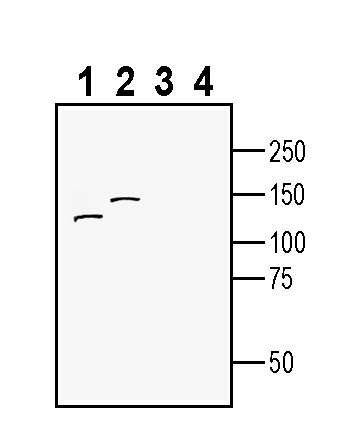Overview
- Peptide CLYQDFRIPLSPVHK, corresponding to amino acid residues 711 - 725 of human ENPP1 (Accession P22413). Extracellular, C-term.

ENPP1 (extracellular) Blocking Peptide (#BLP-NT069)
 Western blot analysis of mouse brain lysate (lanes 1 and 3) and rat brain lysate (lanes 2 and 4):1-2. Anti-ENPP1 (extracellular) Antibody (#ANT-069), (1:400).
Western blot analysis of mouse brain lysate (lanes 1 and 3) and rat brain lysate (lanes 2 and 4):1-2. Anti-ENPP1 (extracellular) Antibody (#ANT-069), (1:400).
3-4. Anti-ENPP1 (extracellular) Antibody, preincubated with ENPP1 Blocking Peptide (BLP-NT069). Western blot analysis of human THP-1 monocytic leukemia cell line lysate (lanes 1 and 4), human HL-60 promyelocytic leukemia cell line lysate (lanes 2 and 5) and human MDA-MB-231 breast adenocarcinoma cell line lysate (lanes 3 and 6):1-3. Anti-ENPP1 (extracellular) Antibody (#ANT-069), (1:200).
Western blot analysis of human THP-1 monocytic leukemia cell line lysate (lanes 1 and 4), human HL-60 promyelocytic leukemia cell line lysate (lanes 2 and 5) and human MDA-MB-231 breast adenocarcinoma cell line lysate (lanes 3 and 6):1-3. Anti-ENPP1 (extracellular) Antibody (#ANT-069), (1:200).
4-6. Anti-ENPP1 (extracellular) Antibody, preincubated with ENPP1 Blocking Peptide (BLP-NT069).
 Expression of ENPP1 in rat spinal cord.Immunohistochemical staining of perfusion-fixed frozen rat spinal cord sections with Anti-ENPP1 (extracellular) Antibody (#ANT-069), (1:1000), followed by goat anti-rabbit-AlexaFluor-488. A. Staining in the dorsal horn region, showed ENPP1 immunoreactivity (green) neuronal profiles (vertical arrows) and glial profiles (horizontal arrows). B. Pre-incubation of the antibody with ENPP1 Blocking Peptide (BLP-NT069), suppressed staining. Cell nuclei are stained with DAPI (blue).
Expression of ENPP1 in rat spinal cord.Immunohistochemical staining of perfusion-fixed frozen rat spinal cord sections with Anti-ENPP1 (extracellular) Antibody (#ANT-069), (1:1000), followed by goat anti-rabbit-AlexaFluor-488. A. Staining in the dorsal horn region, showed ENPP1 immunoreactivity (green) neuronal profiles (vertical arrows) and glial profiles (horizontal arrows). B. Pre-incubation of the antibody with ENPP1 Blocking Peptide (BLP-NT069), suppressed staining. Cell nuclei are stained with DAPI (blue).
- Borza, R. et al. (2022) J. Biol. Chem. 298, 101526.
- Onyedibe, K.I. et al. (2019) Molecules. 24, 4192.
- Roberts, F. et al. (2019) Trends Bio. Sci. 44, 616.
- Carozza, J.A. et al. (2022) PNAS. 119, e2119189119.
- Kato, K. et al. (2018) Nat. Commun. 9, 4424.
- Zhou, Y. et al. (2020) Immunity. 52, 357.
- Ritchie, C. et al. (2019) Mol. Cell. 75, 372.
- Zhou, C. et al. (2020) Immunity. 52, 767.
- Carozza, J.A. et al. (2020) Nat. Cancer. 1, 184.
Ectonucleotide Pyrophosphatase/Phosphodiesterase 1 (ENPP1), also known as Plasma-Cell Membrane Glycoprotein (PC-1) and CD203a, is a member the ecto-enzyme ENPP family that includes seven members (ENPP1-ENPP7)1.
ENPP1 is involved in purinergic signaling as it catalyzes the hydrolysis of ATP or GTP to AMP or GMP, while generating inorganic pyrophosphates (PPi)1,2. Inorganic pyrophosphates inhibit bone and cartilage mineralization, hence making ENPP1 a key regulator of bone and cartilage development and remodeling 2,3. Indeed, several hereditary mineralization or calcification-related disorders, have been linked to loss-of-function mutations of ENPP1, such as general arterial calcification of infancy (GACI) or Cole disease 3.
Recently, an intriguing new role of ENPP1 as a central regulator of immunity and tumor proliferation came to light. It was shown that ENPP1 is the critical enzyme that degrades the stimulator of interferon genes (STING) ligand, cyclic GMP–AMP (cGAMP)4,5. cGAMP was first described as an intracellular second messenger, synthesized by the enzyme cyclic-GMP-AMP synthase (cGAS) in response to self and pathogenic double-stranded DNA in the cytosol. Intracellular signaling of cGAMP is carried through the STING pathway which then directs several antiviral and anticancer cellular response mechanisms 4,5.
cGAMP can also be released to the extracellular space where it can be transported into cells by receptors like MERTK 6, P2X7 6, SLC19A1 7 and LRRC8A 8. ENPP1 is the only known ecto-enzyme that can inactivate extracellular cGAMP to GMP and AMP, and thus functions as an inhibitor of the anti-tumor response elicited by extracellular cGAMP 4,9.
Application key:
Species reactivity key:
Anti-ENPP1 (extracellular) Antibody (#ANT-069) is a highly specific antibody directed against an extracellular epitope of the human protein. The antibody can be used in western blot, immunohistochemistry and flow cytometry applications. It has been designed to recognize ENPP1 from mouse, rat and human samples.

